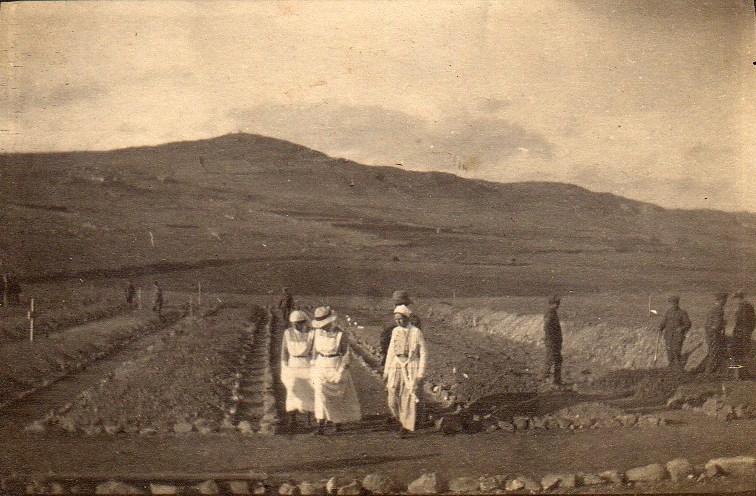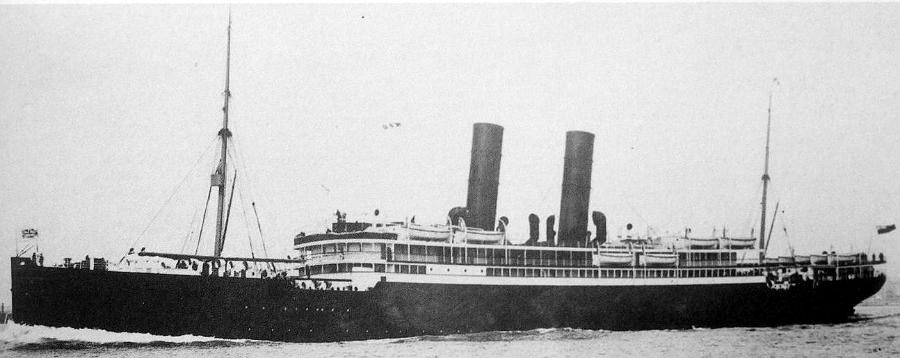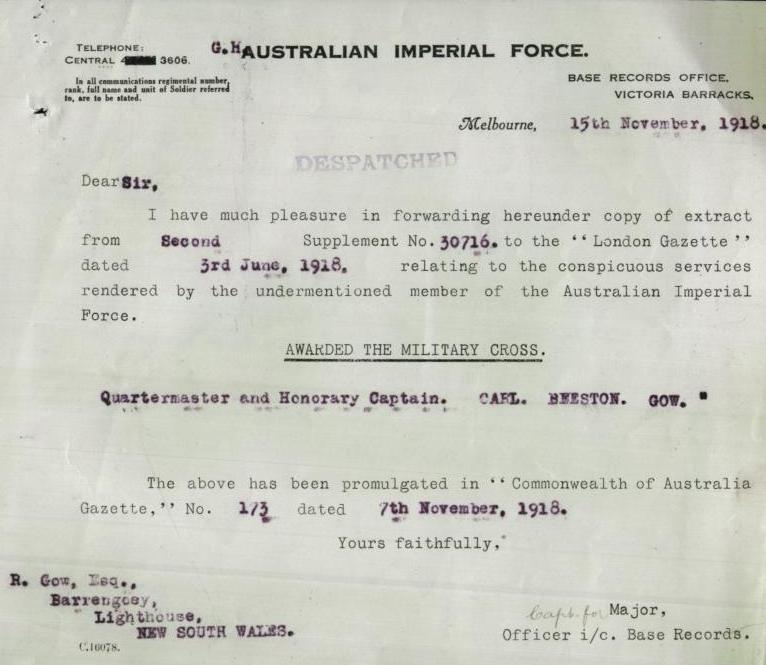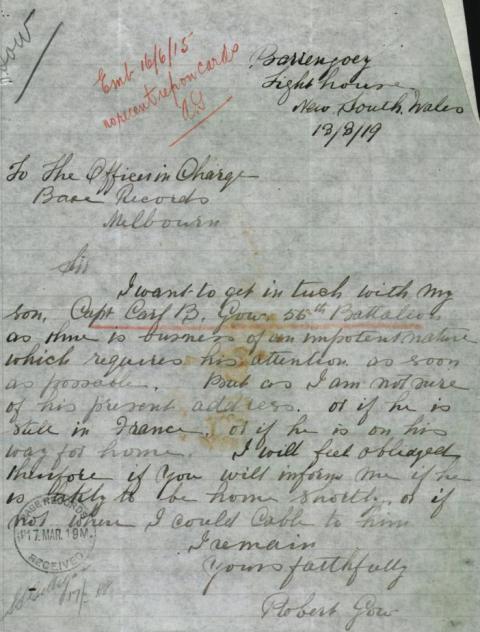November 10 - 16, 2013: Issue 136
Carl Gow’s WWI Service in AIF
Born Carl W J Beeston Gow at Newcastle in March 1889, the youngest son of Robert and Mary, most people think of Gow’s wharf and boatshed, of the Gonsalves family, and of the Gow’s (brother David and father Robert who also worked there as a relieving and second lighthouse keeper) at Barrenjoey Lighthouse or the ship’s wheel from the Helen B Stirling in the foyer of Club Palm Beach (Palm Beach RSL) whenever they think of Carl Gow.
Many an old salt or those who were knee high and met this man were unaware that he was decorated as a result of his service in WWI, that he went in a private and came our a Captain. Carl was wounded at Gallipoli but remained on duty for two days until sent to hospital. He then went on to serve on the Western Front, took the opportunity to visit Paris when on leave, but just ‘got in with it’ when he finally came home.
Signing up on May 28th, 1915 in Liverpool NSW he gave his employment as Mail Order Manager or ‘Under Manager’. By the 16th of June he was embarking on HMAT Karoola A63 as part of the 6th Reinforcements of the 3rd Battalion AIF (New South Wales) [1st Infantry Brigade]. The Karoola was one of a fleet of transport ships leased by the Commonwealth government for the specific purpose of transporting the various AIF formations to their respective overseas destinations. His Majesty's Australian Transports (HMAT) were also detailed to carry various commodity exports to Britain and France. The fleet was made up from British ships and captured German vessels.
The HMAT A63 Karoola weighed 7,391 tons with an average cruise speed of 15 knots or 27.78 kmph. This vessel was owned by the McIlwraith, McEacharn's Line Pty Ltd, Melbourne, and manned by Australian officers and crews, part of our newly formed RAN. The Karoola was leased by the Commonwealth until June 1919.

HMAT Karoola SLV Pic 0_232563 by Allan C. Green 1878-1954 photographer, courtesy State Library of Victoria.
Carl was allotted – 3 blankets, 1 waterproof, 1 jacket/tunic, 1 pair dungarees, 1 Whity hat, 1 pair of boots, 2 singlets but no socks.
Mr Gow was assigned to the 3rd Battalion. The 3rd Battalion was among the first infantry units raised for the AIF during the First World War. Like the 1st, 2nd and 4th Battalions it was recruited from New South Wales and, together with these battalions, formed the 1st Brigade.
The battalion was raised within a fortnight of the declaration of war in August 1914 and embarked just two months later. After a brief stop in Albany, Western Australia, the battalion proceeded to Egypt, arriving on 2 December. The battalion took part in the Anzac landing on 25 April 1915 as part of the second and third waves and served there until the evacuation in December.
In August, this battalion took part in the attack on Lone Pine.(1.)
Carl survived this battle but on the 21st of August 1915 he was wounded. His records state he remained on duty and 'Wounded MFC', meaning 'Mortar Fire Controller' is next to this notice in his War Records. On the 23rd of August he was sent to hospital and on the 24th was transferred to Mudros as a result of his wounds and admitted into the 1st Australian Casualty Clearance Station there.
Mudros is a small Greek port on the Mediterranean island of Lemnos. It was utilized during World War One as a base from which to launch the Gallipoli campaign as the Allies attempted to seize control of the Dardanelles Straits, some 50km away. There is a cemetery there in which fifty Australians are buried.

ANZAC Graveyard at Lemnos- [no inscription - Nurses, soldiers, a graveyard, probably Lemnos, late 1915] [Joseph Cecil Thompson - presumed photographer]
His father had this to say about his being wounded so soon after being deployed:
PRIVATE CARL GOW.
Mr. Robert Gow, of East Newcastle, has recieved an intimation from the Defences Department, that his son, Prtvate Carl B. Gow, had been wounded at the Dardanelles. In forwarding the information for pubIication, Mr. Gow says:--"I may state he enlisted in June last, and was only one weekend In camp, when he left with the 6th Reinforcements of the Third Battalion, on 16th June, arriving In Egypt on 17th July. He spent only seven days in Egypt, and then went to the front, He never had a day's training In his life, and I think greater care should be taken, not to allow untrained lads to go straight into the fighting line, no matter how keen their desire to get there may be. Before he enlisted, my son was employed at Winn and Company's, Oxford-street, Sydney. He was in charge of their country order department. He had been with Winn and Company since he was fourteen years of age. He is now 20. PRIVATE CARL GOW. (1915, September 14). Newcastle Morning Herald and Miners' Advocate (NSW : 1876 - 1954) , p. 5. Retrieved from http://nla.gov.au/nla.news-article137969100
Tall al Kebir or Tel-el-Kebir ('great mound') is 110 km north-north-east of Cairo and 75 kilometres south of Port Said on the edge of the Egyptian desert at the altitude of 29 m. During the Gallipoli landings and the Sinai and Palestine Campaign of the First World War, Tel el Kebir was a training centre for the First Australian Imperial Force reinforcements, No 2 Australian Stationary Hospital, and also a site of a large prisoner of war camp. Some 40,000 Australians camped in a tent city at Tel-el-Kebir of six miles in length. A military railway was eventually constructed to take troops from the camp to their vessels in Alexandria and elsewhere for embarkation.
The Tel-el-Kebir village was described by an Australian soldier in 1916 as 'a very dirty little place with a few dirty shops in it'
An Allied War Memorial Cemetery is situated about 175 metres east of the railway station and the Ismailia Canal. The War Memorial Cemetery was used from June 1915 to July 1920, and was enlarged after the Armistice with many graves being transferred in from other temporary interment sites. The camp was converted for use as a holding camp for refugees fleeing the Russian Civil War from what used to be southern Russian Empire.
On the 19th of February, 1916 Carl Gow, along with what was left of the 3rd Battalion was transferred to the 55th Battalion. The 55th Battalion was raised in Egypt on 12th of February 1916 as part of the “doubling” of the AIF. Half of its recruits were Gallipoli veterans from the 3rd Battalion, and the other half, fresh reinforcements from Australia.
Carl’s war Records state that in March the 55th Battalion embarked at Alexandria on the HMT Caledonian and disembarked at Marseilles, France soon after.
The 9,223-ton S.S. Caledonia was a British passenger ship built for the Anchor Line by David and William Henderson & Company at Glasgow, Scotland. She was launched on 22 October 1904 and plied a tourist route between Glasgow and New York city. When World War I erupted in August 1914, the British government requisitioned Caledonia and converted this once elegant liner into a troop ship. Post conversion, Caledonia could carry 3,074 troops and 212 horses. For more than two years, the ship carried soldiers and their equipment to France and to various locations around the Mediterranean.

S.S. Caledonia prior to World War I, date and place unknown. Photograph courtesy of Old Ship Photo Galleries (http://www.photoship.co.uk).
The Australian War Museum states:
‘Reflecting the composition of the 3rd, the 55th was predominantly composed of men from New South Wales. The battalion became part of the 14th Brigade of the 5th Australian Division.
Arriving in France on 30 June 1916, the battalion entered the frontline trenches for the first time on 12 July and fought its first major battle at Fromelles a week later. The battle was a disaster, resulting in heavy casualties across the division. Although in reserve, the 55th was quickly committed to the attack and eventually played a critical role, forming the rearguard for the 14th Brigade’s withdrawal. Despite its grievous losses the 5th Division continued to man the front in the Fromelles sector for a further two months.
The Australians were given a gradual introduction to the Western Front fighting conditions. It was a new experience for them. They trained with some of the latest weapons of modern warfare including poisonous gas. Things became more serious when they moved into the front line trenches in a section around Armentières which had been dubbed "the nursery".
Meanwhile the British army, under Sir Douglas Haig, was about to conduct a mighty offensive in the Somme region, 100 km away to the south. The battle was set for 1 July, and it would continue for five months. It began disastrously; there were 58,000 casualties on the first day and little ground was taken. As the fighting went on three Australian divisions, the 1st, 2nd and 4th Divisions, were eventually drawn in, leaving the 5th Division under Major General James McCay, behind. This newly arrived 5th Division would be the first to see heavy action.
Just beyond the line held by the Australians in the nursery sector was the shell-damaged village of Fromelles standing on a strategically important ridge behind the German front line. The surrounding battlefield had been fought over by the British during 1915, and now a fresh attack against the ridge was planned. It was hoped that a strong diversionary attack here would prevent the Germans sending troops to reinforce their defences on the Somme. The attack was set for the evening of 19 July and the Australians and another untried British division, the 61st, were chosen to make the effort.
The attacking troops were not familiar with Fromelles itself because it was in German hands; for them the nearest village was Fleurbaix which stood behind their own lines. For a long time afterwards many would refer to the events about to unfold as the battle of Fleurbaix, but eventually the name of Fromelles stuck and today it is by that name that the battle is known.
On this battleground the opposing trench lines faced each other across a flat, boggy and overgrown no man's land criss-crossed with drainage ditches and a small stream. Because of the high water table, the trenches were mostly above-ground breastworks. Of deadly concern, sited within the enemy lines was the "Sugarloaf" salient. This was a heavily manned position with many machine-guns that jutted towards the British lines. Fire from here could enfilade any troops advancing towards the ridge. The enemy held the high ground and all of the advantages.’(1.)
Although the Australian Imperial Force strength in France varied in response to battle casualties and problems with recruiting, it never fell below 117 000 men. Its battle casualties for three years of trench warfare between 1916 and 1918 amounted to over 181 000 men of whom more than 46 000 died. Another 114 000 were wounded, 16 000 were gassed and almost 4000 taken prisoner. In terms of total deaths per 1000 men mobilised, the Australian Imperial Force figure was 145 – the highest of all the British Commonwealth armies.
Carl Gow was promoted to R.Q.M.S.W.O. Class II on the 14th of April,1916 (Regimental Quartermaster Sergeant) - The RQMS is the senior assistant to the quartermaster of a regiment or battalion and also usually functions as the deputy regimental sergeant major. Some units have more than one. RQMS was a separate rank until 1915, when it became a warrant officer appointment with the creation of the rank of warrant officer class II.
Carl Gow was promoted again to 2nd Lieutenant on August 2nd, 1916 and Lieutenant on the 9th of February, 1917.
As a Quartermaster he made trips to and from Rouen. During the First World War the British used Rouen as a supply base and there were many military hospitals. It is also the place well known for being where you may find Notre Dame cathedral and an astronomical clock dating back to the 16th century, though the movement is considerably older (1389), is located in the Gros Horloge street.
Other famous structures include Rouen Castle, the Gothic Church of St Maclou (15th century); the Tour Jeanne d'Arc, where Joan of Arc was brought in 1431 to be threatened with torture (contrary to popular belief, she was not imprisoned there) and the Museum of Fine Arts and Ceramics which contains a splendid collection of faïence and porcelain for which Rouen was renowned during the 16th to 18th centuries. (2.)
Carl Gow was mentioned in dispatches 25th December 1917; London Gazette; Sir Douglas Haig’s Despatch
He was Awarded the Military Cross on the 4th of June 1918. The Military Cross is granted in recognition of "an act or acts of exemplary gallantry during active operations against the enemy on land to all members, of any rank in Our Armed Forces…"
Carl Gow’s records record these words and also the dates ‘from 26.2.1917 to 25.9.1917’. This may be why (from those who met him when he came to Palm Beach):
You still quite young when you met Carl?
Peter Verrills: he was a wonderful man. A man full of knowledge.
Did you know he was a Captain at the end of WWI?
Pete: yes, in the Army, First world war. He got blasted to buggery – they sent him to France and then he walked away.
John Arblaster: he found this solider with his leg blown off, and he threw his greatcoat over him, to keep him warm until the Medics got to him. Later on in life when he was here at the boatshed, there was a fella that bought a house up on the hill there. His name was Harold Richardson and this turned out to be the solider who he had saved.
Peter V: Harold Richardson, unbeknownst to Carl, was his batman. They were good mates until he died and Harold became the secretary of the Palm Beach RSL when that first opened. I remember Harold as a kid; he used to get around in a Ford with a big gas burner on the back of it because there wasn’t enough petrol then.
During this period the 55th Battalion, after a freezing winter manning trenches in the Somme Valley, were part of the early 1917 advance that followed the German retreat to the Hindenburg Line. Although spared the assault they did defend gains made during the second battle of Bullecourt. Later in the year, the AIF’s focus of operations switched to the Ypres sector in Belgium. The 55th’s major battle here was at Polygon Wood on 26 September.
MILITARY HONOURS. The "London Gazette" contains the following list of members of the Australian and New Zealand Expeditionary Forces who have been decorated: BARS TO MILITARY CROSSES. Australians.-Captain F. E. Fairweather, Lieutenant J. H. Julln. MILITARY CROSSES. Australians.- Quarter masters R. J. Forrest, C. B. Gow, MILITARY HONOURS. (1918, June 6). The Sydney Morning Herald (NSW : 1842 - 1954), p. 7. Retrieved from http://nla.gov.au/nla.news-article15786666

Later that year he was granted Leave and went to Paris – 27th of September 1918. On the 13th of December 1918 Carl was made an Honorary Captain.
On March 1st 1919 he was sent on Leave to the U.K. for Investiture, reporting to the Headquarters in London on the 4th of March.
In 1920 he also received the 1914–15 Star, a campaign medal of the British Empire, for service in World War I, the British war Medal and the Victory Medal.
Meanwhile his father, Robert sent a letter from Barrenjoey Lighthouse dated 13.3.1919 requesting information about Carl who is still in France or on way home??? No one knew where he was.

Carl Gow returned to Australia per the ‘Traz os montes’ or ‘Eros Montes’ as spelled in some files.
He disembarked on the 22nd of May 1919 and made his way here to be reunited with his family then lightkeepers at Barrenjoey where he also then worked as a relieving lightkeeper. It was a few days over four years when he finally came home and days before he resumed or took up a new way of life.
His smile from the few photographs* shared by those who knew him show he just decided to get on with life. Mr Gow was, after all, a man who thought nothing of rowing from Barrenjoey to Newcastle to take part in a SLS Boat Carnival once he did get home and became part of the permanent Palm Beach community.
He was truly a Honorary Captain both on land and at sea.
___________________________________
References.
1. The 3rd Battalion – Australian War Museum website.
2. Rouen. (2013, October 17). In Wikipedia, The Free Encyclopedia. Retrieved from http://en.wikipedia.org/w/index.php?title=Rouen&oldid=577624738
*A fire which destroyed his possessions in 1922 accounts for the lack of pictorial records prior to this date.

Carl Gow at far right, back row. Image Courtesy Tom Gilbert who is wearing the white hat, pictured with members of Lipscombe, Gilbert and Gonsalves families
Carl Beeston Gow Service Record Compiled by A J Guesdon, 2013.